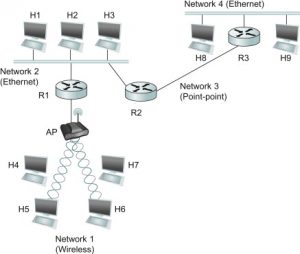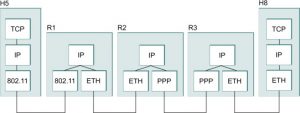What is Internetworking?
What is an Internetworking?
We use the term internetworking, or sometimes just internet with a lowercase i, to refer to an arbitrary collection of networks interconnected to provide some sort of host-to-host packet delivery service. For example, a corporation with many sites might construct a private internetwork by interconnecting the LANs at their different sites with point-to-point links leased from the phone company. When we are talking about the widely used global internetwork to which a large percentage of networks are now connected, we call it the Internet with a capital I. In keeping with the first-principles approach of this book, we mainly want you to learn about the principles of “lowercase i” internetworking, but we illustrate these ideas with real-world examples from the “big I” Internet.
Another piece of terminology that can be confusing is the difference between networks, subnetworks, and internetworks. We are going to avoid subnetworks (or subnets) altogether until Section 3.2.5. For now, we use network to mean either a directly connected or a switched network of the kind described in the previous section and the previous chapter. Such a network uses one technology, such as 802.11 or Ethernet. An internetwork is an interconnected collection of such networks. Sometimes, to avoid ambiguity, we refer to the underlying networks that we are interconnecting as physical networks. An internet is a logical network built out of a collection of physical networks. In this context, a collection of Ethernets connected by bridges or switches would still be viewed as a single network.
Figure 3.14 shows an example internetwork. An internetwork is often referred to as a “network of networks” because it is made up of lots of smaller networks. In this figure, we see Ethernets, a wireless network, and a point-to-point link. Each of these is a single-technology network. The nodes that interconnect the networks are called routers. They are also sometimes called gateways, but since this term has several other connotations, we restrict our usage to router.

The Internet Protocol is the key tool used today to build scalable, heterogeneous internetworks. It was originally known as the Kahn-Cerf protocol after its inventors.6 One way to think of IP is that it runs on all the nodes (both hosts and routers) in a collection of networks and defines the infrastructure that allows these nodes and networks to function as a single logical internetwork. For example, Figure 3.15 shows how hosts H5 and H8 are logically connected by the internet in Figure 3.14, including the protocol graph running on each node. Note that higher-level protocols, such as TCP and UDP, typically run on top of IP on the hosts.

Most of the rest of this chapter is about various aspects of IP. While it is certainly possible to build an internetwork that does not use IP—for example, Novell created an internetworking protocol called IPX, which was in turn based on the XNS internet designed by Xerox—IP is the most interesting case to study simply because of the size of the Internet. Said another way, it is only the IP Internet that has really faced the issue of scale. Thus, it provides the best case study of a scalable internetworking protocol.
